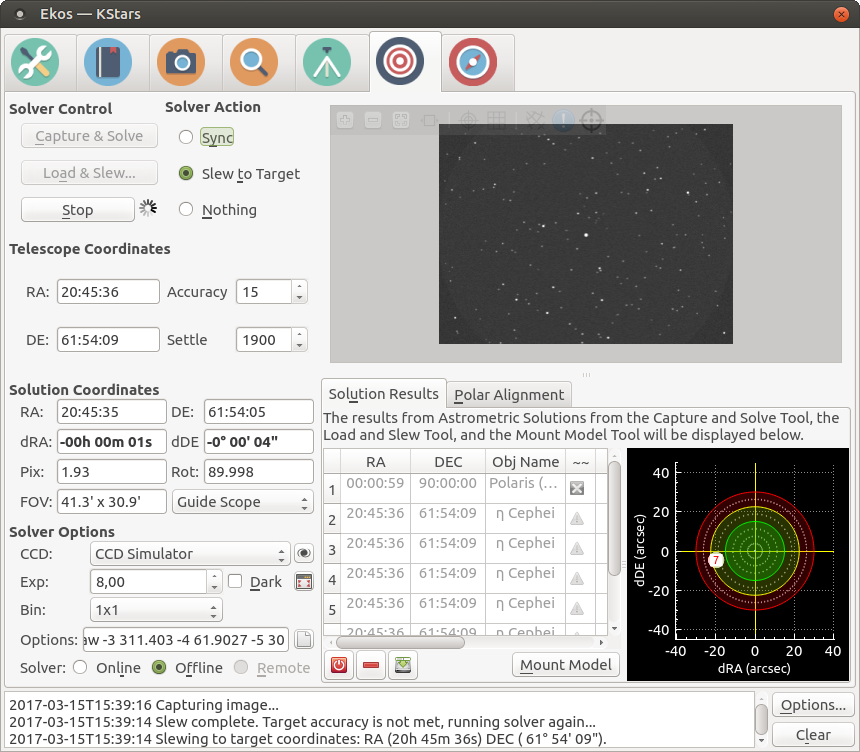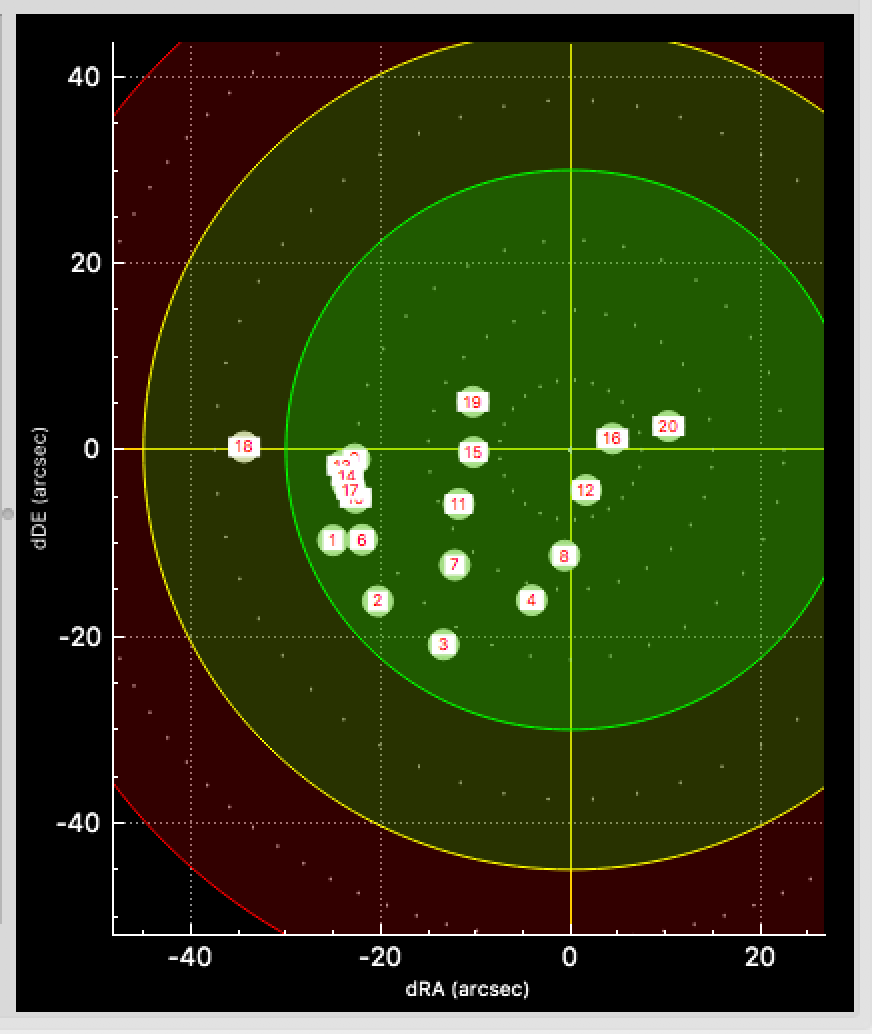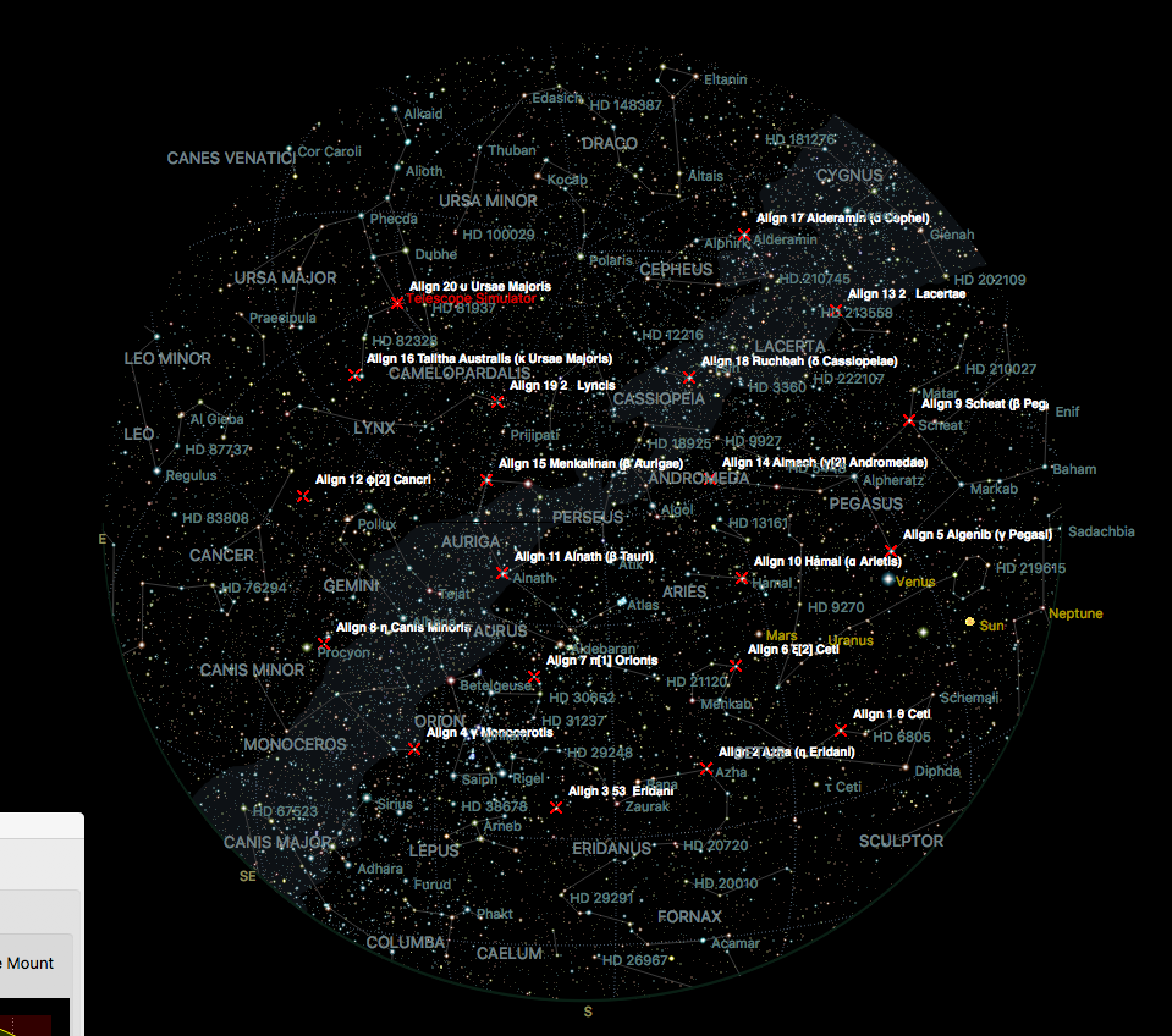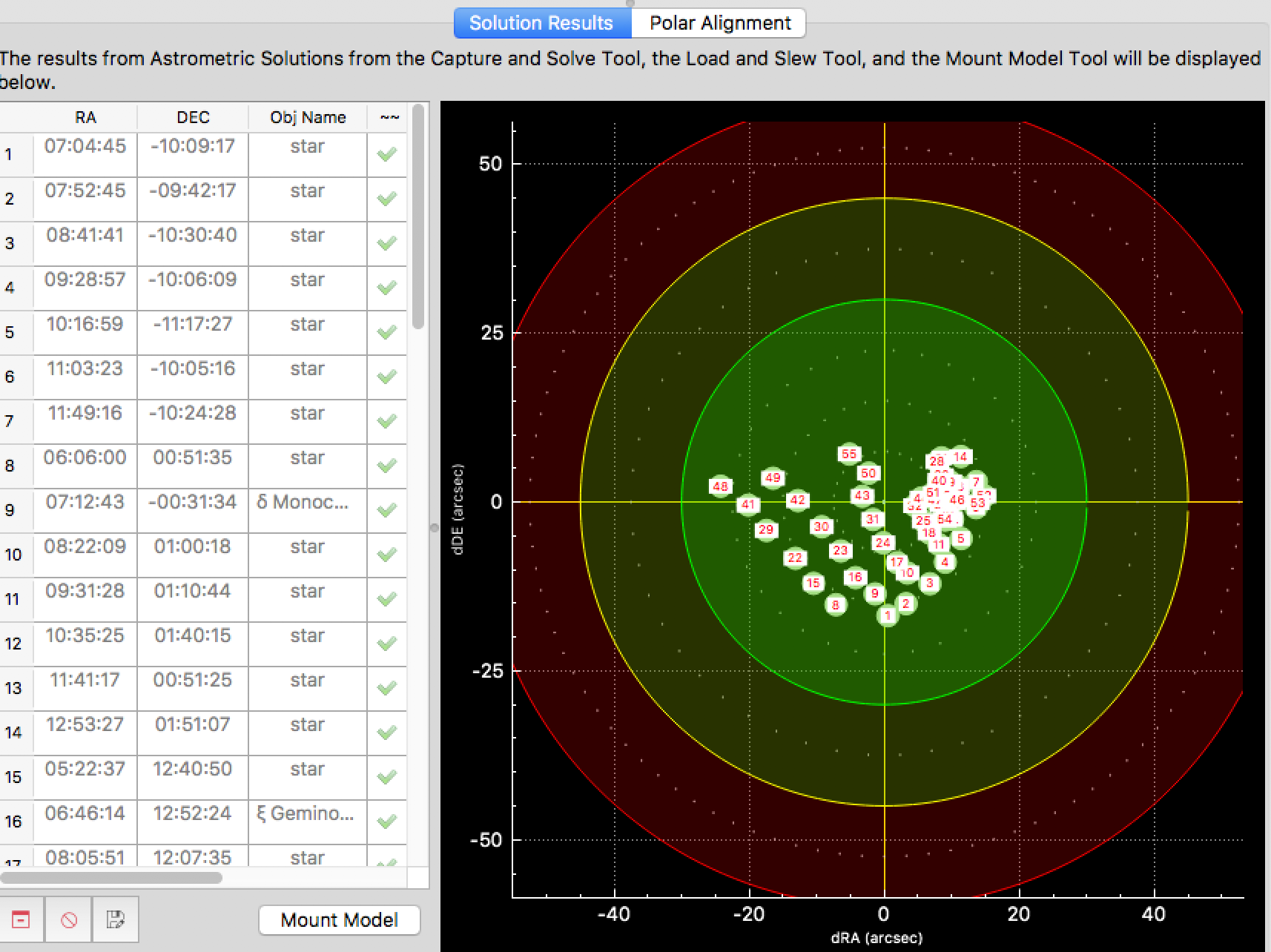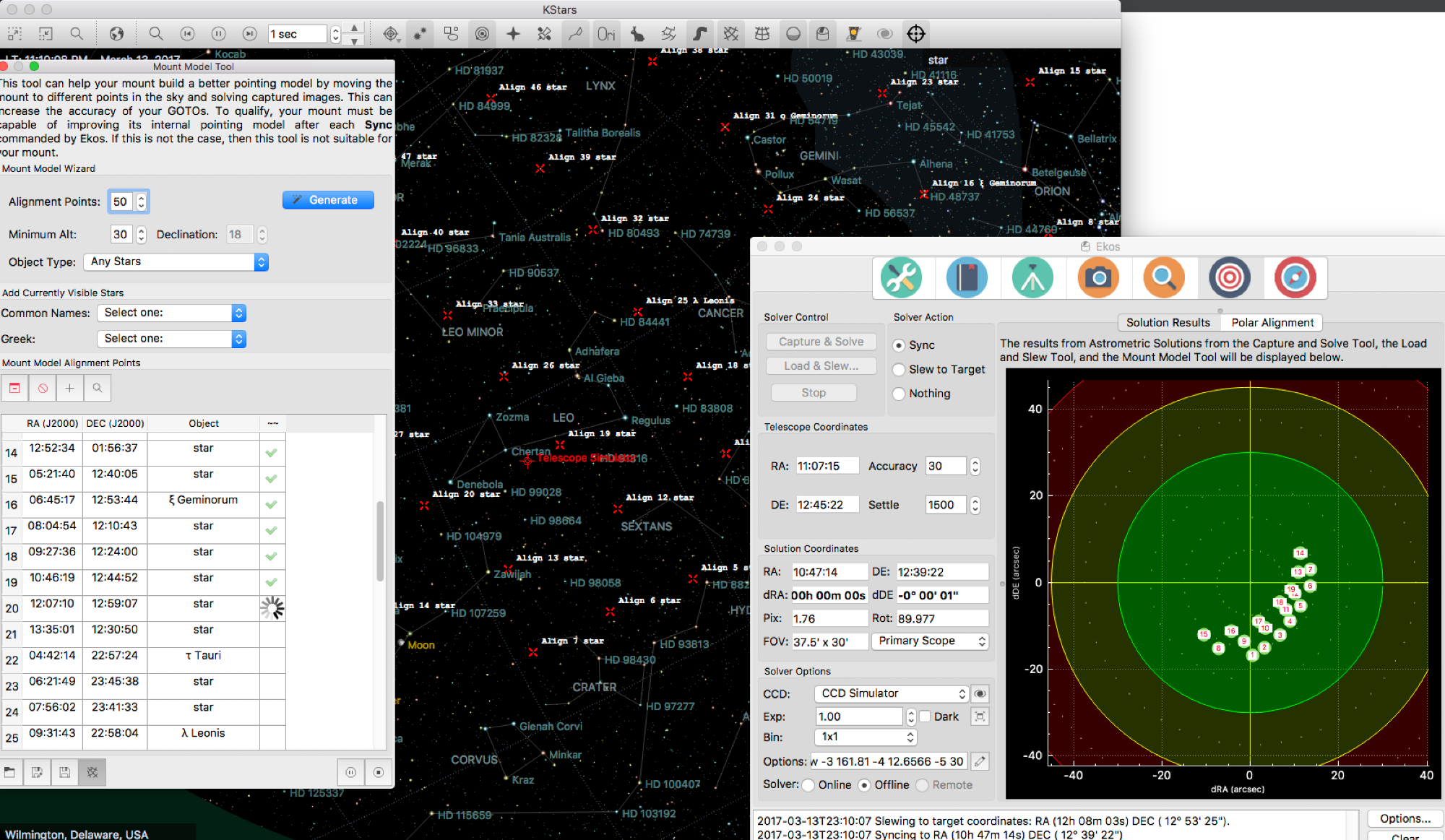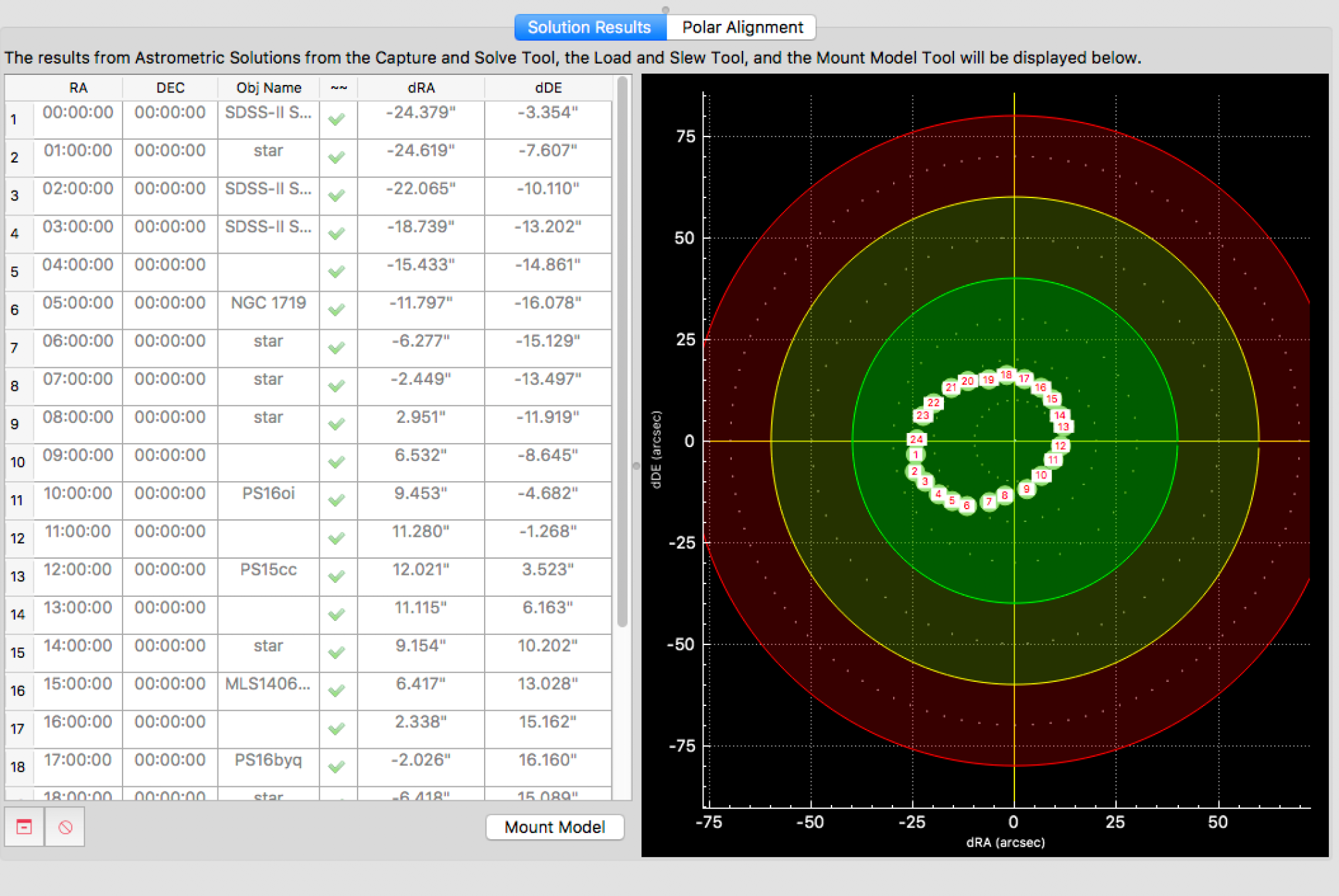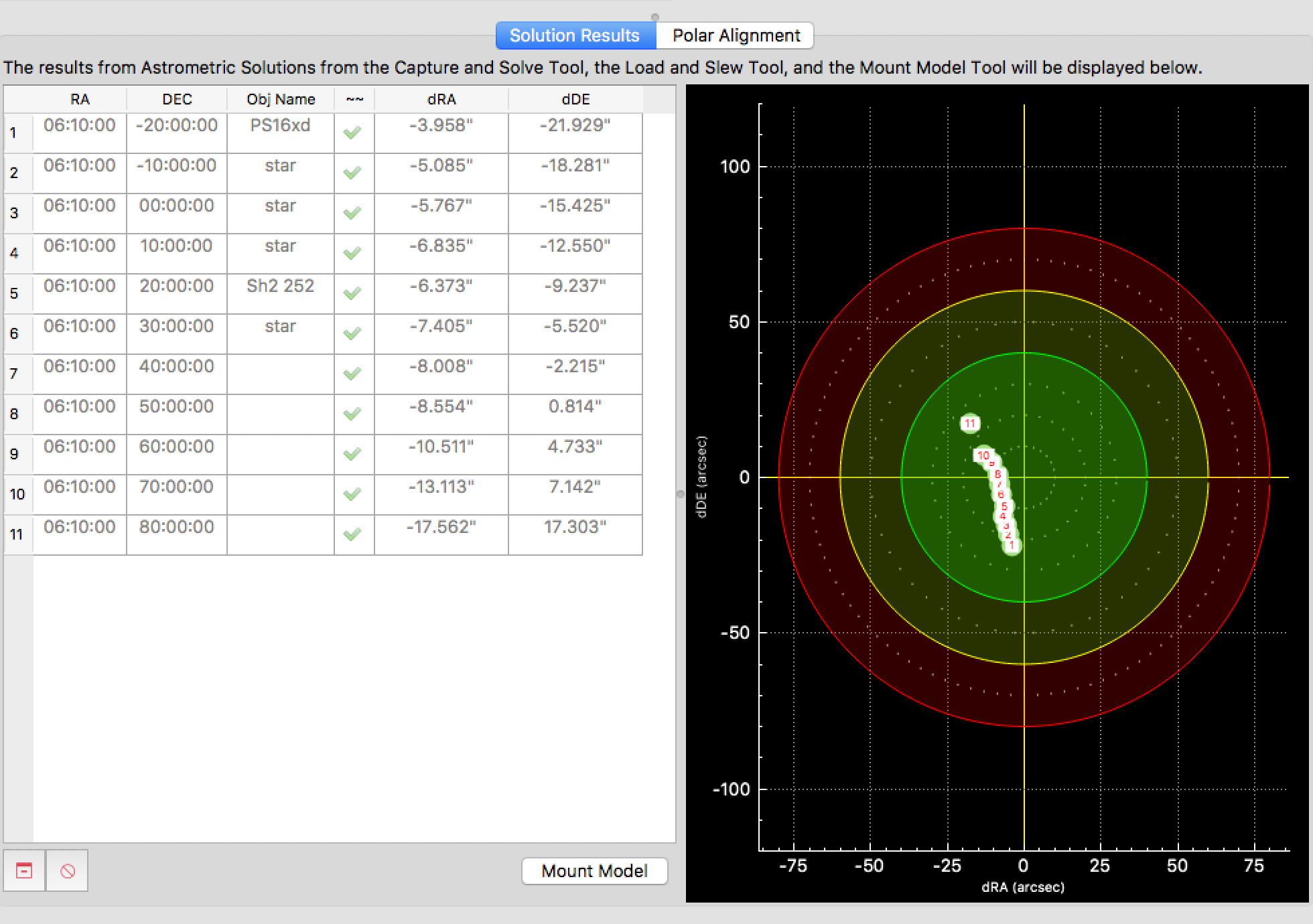INDI Library v2.0.7 is Released (01 Apr 2024)
Bi-monthly release with minor bug fixes and improvements
Exciting new tool in Ekos for Mount Modelling
Replied by Patrick on topic Exciting new tool in Ekos for Mount Modelling
For the test I evoke I just used simulators. And all looks fine, I have the good focal and aperture.
But for this object HD198149 the solver never converge and doesn't move the simulator mount. The object is 61° DE which is far from the North Pole.
I tried to do the same for Alderamin in Cepheus and the result was identical.
I have set the telescope focal and aperture to respectively 777 and 111mm. The camera simulator is 1280x960 pixels of 3,75µm. And all the index files covering the computed field (41.3' x 30.9') are presents (index-4208.fits 2Mass and index-4108.fits Tycho2).
Hum, maybe I am silly or Alzheimer. I guess the CCD simulator cannot change the view of the targeted field. So, the process can enter in infinite loop never finding the good solution. If I am right, I am sorry, this topic is not a good one.
But now I understand the philosophy of your tool and YES the automatic mount model is a great improvement and a really good use of astrometry. I hope to test it very soon. Maybe tonight if the weather remain clement.
Please Log in or Create an account to join the conversation.
- Rob Lancaster
-

- Offline
- Supernova Explorer
-

- Posts: 2877
- Thank you received: 812
Replied by Rob Lancaster on topic Exciting new tool in Ekos for Mount Modelling
Please Log in or Create an account to join the conversation.
- Rob Lancaster
-

- Offline
- Supernova Explorer
-

- Posts: 2877
- Thank you received: 812
Replied by Rob Lancaster on topic Exciting new tool in Ekos for Mount Modelling
It shouldn't start the capture until it arrives at the star. do you know the circumstances under which this happens or is it random?
Please Log in or Create an account to join the conversation.
Replied by Patrick on topic Exciting new tool in Ekos for Mount Modelling
Please Log in or Create an account to join the conversation.
- Jarno Paananen
-

- Offline
- Elite Member
-

- Posts: 474
- Thank you received: 168
Replied by Jarno Paananen on topic Exciting new tool in Ekos for Mount Modelling
Please Log in or Create an account to join the conversation.
- Rob Lancaster
-

- Offline
- Supernova Explorer
-

- Posts: 2877
- Thank you received: 812
Replied by Rob Lancaster on topic Exciting new tool in Ekos for Mount Modelling
Please Log in or Create an account to join the conversation.
- Rob Lancaster
-

- Offline
- Supernova Explorer
-

- Posts: 2877
- Thank you received: 812
Replied by Rob Lancaster on topic Exciting new tool in Ekos for Mount Modelling
Please Log in or Create an account to join the conversation.
- Rob Lancaster
-

- Offline
- Supernova Explorer
-

- Posts: 2877
- Thank you received: 812
Replied by Rob Lancaster on topic Exciting new tool in Ekos for Mount Modelling
here is a demonstration of what I meant about the built in error in the telescope simulator, a series of 20 solutions spread across the sky using the simulator and the mount modeling tool using a wizard generated grid pattern. I just ran this a few minutes ago. Interestingly, the pattern is slightly different than one I ran the other day. and one point is even outside of my circle, which is interesting too. Since I made this tool, I have run several variations of patterns like this with the simulator and it produces interesting patterns. What I don't actually know is whether the error I am seeing is error in the simulators, error in the astrometry.net files, or if it is a periodic error simulation in INDI CCD, which Jasem suggested it may be.
Please Log in or Create an account to join the conversation.
- Rob Lancaster
-

- Offline
- Supernova Explorer
-

- Posts: 2877
- Thank you received: 812
Replied by Rob Lancaster on topic Exciting new tool in Ekos for Mount Modelling
Please Log in or Create an account to join the conversation.
- Rob Lancaster
-

- Offline
- Supernova Explorer
-

- Posts: 2877
- Thank you received: 812
Replied by Rob Lancaster on topic Exciting new tool in Ekos for Mount Modelling
If you see any pattern to when it happens, please let me know. So far, I haven't seen it and I have been running it quite a bit. I have only been using the simulators recently due to a lack of good weather.
Please Log in or Create an account to join the conversation.
- Rob Lancaster
-

- Offline
- Supernova Explorer
-

- Posts: 2877
- Thank you received: 812
Replied by Rob Lancaster on topic Exciting new tool in Ekos for Mount Modelling
Please Log in or Create an account to join the conversation.
- Jarno Paananen
-

- Offline
- Elite Member
-

- Posts: 474
- Thank you received: 168
Replied by Jarno Paananen on topic Exciting new tool in Ekos for Mount Modelling
Now it seems to happen pretty much every time after the first star, log shows rows like this:
2017-03-16T09:32:11 Capturing image...
2017-03-16T09:32:09 Slew complete. Solving Alignment Point. . .
2017-03-16T09:32:09 Slewing to target coordinates: RA (01h 20m 22s) DEC ( 27° 21' 09").
ie. it starts slewing and immediately thinks it's complete even though the telescope simulator has just started slewing taking a few seconds to complete. All I did was connect simulators (telescope and ccd), go to mount model dialog and press generate and start.
For the first star it works correctly:
2017-03-16T09:32:02 Capturing image...
2017-03-16T09:32:00 Slew complete. Solving Alignment Point. . .
2017-03-16T09:31:24 Slewing to target coordinates: RA (15h 43m 27s) DEC ( 26° 14' 36").
2017-03-16T09:31:24 The Mount Model Tool is Starting.
This is Intel i5-6500 quad core machine with indi and kstars compiled from current git, running Ubuntu 16.04.
Edit: I also tried with EQMod simulator instead of telescope simulator and the behavior is the same except EQMod also complains as the mount model is trying to sync the mount while it's still slewing:
2017-03-16T09:48:08 Solver aborted after 4 seconds
2017-03-16T09:48:08 Syncing failed!
2017-03-16T09:48:08 Syncing to RA (17h 38m 51s) DEC ( 16° 54' 19")
2017-03-16T09:48:08 Syncing failed!
2017-03-16T09:48:08 Syncing to RA (17h 38m 51s) DEC ( 16° 54' 19")
2017-03-16T09:48:08 Slewing failed!
2017-03-16T09:48:08 Slewing to target coordinates: RA (15h 43m 27s) DEC ( 26° 14' 36").
2017-03-16T09:48:08 Syncing to RA (17h 38m 51s) DEC ( 16° 54' 19")
2017-03-16T09:48:08 Solution coordinates: RA (17h 38m 51s) DEC ( 16° 54' 19") Telescope Coordinates: RA (00h 38m 16s) DEC ( 87° 55' 37")
2017-03-16T09:48:08 Solver completed in 4 seconds.
2017-03-16T09:48:04 Starting solver...
2017-03-16T09:48:04 Image received.
2017-03-16T09:48:01 Capturing image...
2017-03-16T09:48:00 Slew complete. Solving Alignment Point. . .
2017-03-16T09:48:00 Slewing to target coordinates: RA (00h 00m 09s) DEC ( 6° 57' 28").
Please Log in or Create an account to join the conversation.

